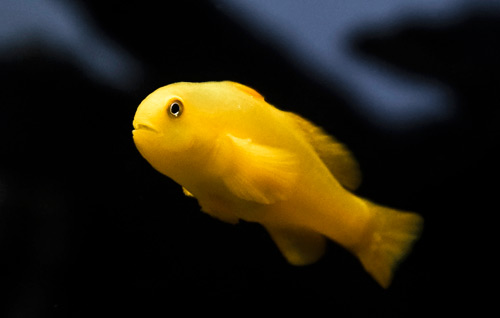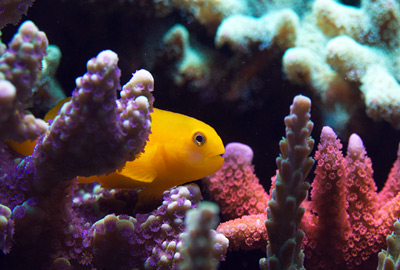Nano marine aquarium enthusiasts must be very discerning in their livestock selections to ensure any specimens they choose won’t outgrow their systems. Reaching a maximum size that can best be described as miniscule, the yellow clown goby (Gobiodon okinawae) is a pretty safe bet in this regard. It’s also charming, attractively colored, relatively outgoing and active, and typically very inexpensive to boot.
Physical traits
G. okinawae is a uniform canary yellow in coloration. Its general body shape is somewhat similar to that of clownfishes, hence the “clown goby” moniker applied to it and its congeners. Size-wise, this western Pacific species is among the smallest fish available in the hobby, growing no larger than around 1 to 1½ inches.
Feeding
This goby will usually accept a variety of small meaty items, such as mysis shrimp, enriched brine shrimp, Cyclops, finely chopped mollusk or crustacean flesh, frozen formulations such as Fish Frenzy®, etc. However, I’ve heard/read many reports of specimens being reluctant to feed initially. Make sure any specimen you’re considering is eating at your LFS before you make a purchase. Also, avoid any specimens that appear skinny and emaciated, as they are unlikely to recover. Offer several small feedings per day.
Housing
As stated in the headline, G. okinawae is an ideal nano candidate, meaning it can be kept in tanks as small as 10 gallons. In nature, it resides among the branches of stony corals, specifically Acropora spp. However, as with clownfishes and their host anemones, it’s not necessary to keep clown gobies with a host coral in captivity. If you keep a breeding pair in a tank containing Acropora, be aware that the female will lay her eggs among the coral’s branches, likely killing the polyps at the attachment site.

Compatibility
Being a very small species, G. okinawae should not be kept with any fish large enough to swallow it. I’ve never, to my recollection (always maintain plausible deniability!), tasted a yellow clown goby, but supposedly they produce a toxic, nasty-tasting mucus that makes them unpalatable to predators. Still, I wouldn’t take the chance. Apart from that, any small, equally peaceful tankmates should be fine.
As far as conspecifics are concerned, if your system is at the smaller end of the scale, I would keep only one specimen or a breeding pair (any two kept together should become a breeding pair as this species is a protogynous hermaphrodite, with all individuals starting out as females and changing sex as needed for reproductive purposes). In tanks affording space for multiple territories, several individuals can be kept together without too much squabbling.
Despite the aforementioned consideration regarding branching stony corals and females’ egg-laying habits, G. okinawae is generally a great candidate for reef systems.



